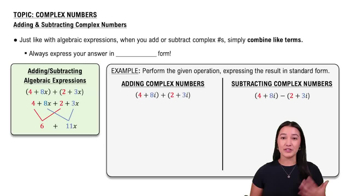Here are the essential concepts you must grasp in order to answer the question correctly.
Order of Operations
The order of operations is a set of rules that dictates the sequence in which mathematical operations should be performed to ensure consistent results. The acronym PEMDAS (Parentheses, Exponents, Multiplication and Division (from left to right), Addition and Subtraction (from left to right)) is commonly used to remember this order. Following these rules is crucial for accurately evaluating expressions.
Recommended video:
Algebraic Operations on Vectors
Multiplication and Division
Multiplication and division are fundamental arithmetic operations that are performed from left to right in an expression, according to the order of operations. In the expression provided, both operations must be evaluated before any addition or subtraction. Understanding how to correctly apply these operations is essential for solving the expression accurately.
Recommended video:
Powers Of Complex Numbers In Polar Form (DeMoivre's Theorem) Example 1
Subtraction
Subtraction is the operation of finding the difference between two numbers. In the context of the expression, it is the final operation to be performed after evaluating multiplication and division. Recognizing how subtraction interacts with other operations is important for arriving at the correct final result.
Recommended video:
Adding and Subtracting Complex Numbers
 Verified step by step guidance
Verified step by step guidance Verified Solution
Verified Solution



 7:48m
7:48m